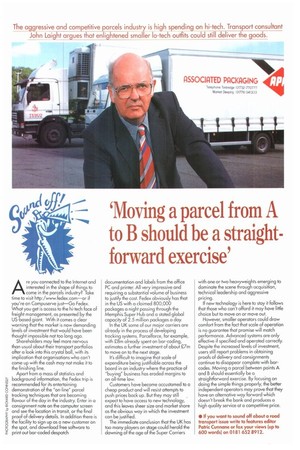'Moving a parcel from A to B should be a straight forward exercise'
Page 54

If you've noticed an error in this article please click here to report it so we can fix it.
Are you connected to the Internet and interested in the shape of things to come in the parcels industry? Take time to visit http:/www.fectex.com—or if you're on Compuserve just—Go Fedex. What you get is access to the hi-tech face of freight management, as presented by the US-based giant. With it comes a clear warning that the market is now demanding levels of investment that would have been thought impossible not too long ago. Shareholders may feel more nervous than usual about their transport portfolios after a look into this crystal all, with its implication that organisations who can't come up with the cash may not make it to the finishing line.
Apart from a mass of statistics and background information, the Fedex trip is recommended for its entertaining demonstration of the "on-line" parcel tracking techniques that are becoming flavour of the day in the industry. Enter in a consignment note on the computer screen and see the location in transit, or the final proof of delivery details. In addition there is the facility to sign up as a new customer on the spot, and download free software to print out bar-coded despatch documentation and labels from the office PC and printer. All very impressive and requiring a substantial volume of business to justify the cost. Fedex obviously has that in the US with a claimed 800,000 packages a night passing through the Memphis Super Hub and a stated global capacity of 2.5 million packages a day.
In the UK some of our major carriers are already in the process of developing tracking systems. Parcelforce, for example, with 28m already spent on bar-coding, estimates a further investment of about £7m to move on to the next stage.
It's difficult to imagine that scale of expenditure being justifiable across the board in an industry where the practice of "buying" business has eroded margins to an all-time low.
Customers have become accustomed to a cheap product and will resist attempts to push prices back up. But they may still expect to have access to new technology, and this leaves sheer size and market share as the obvious way in which the investment can be justified. The immediate conclusion that the UK has too many players on stage could herald the dawning of the age of the Super Carriers with one or two heavyweights emerging to dominate the scene through acquisition, technical leadership and aggressive pricing. If new technology is here to stay it follows that those who can't afford it may have little choice but to move on or move out.
However, smaller operators could draw comfort from the fact that scale of operation is no guarantee that promise will match performance. Advanced systems are only effective if specified and operated correctly. Despite the increased levels of investment, users still report problems in obtaining proofs of delivery and consignments continue to disappear complete with barcodes. Moving a parcel between points A and B should essentially be a straightforward exercise. By focusing on doing the simple things properly, the better independent operators may prove that they have an alternative way forward which doesn't break the bank and produces a high quality service at a competitive price.
















































































































